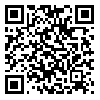Volume 14, Issue 3 (Vol.14, No.3, 2018)
irje 2018, 14(3): 234-245 |
Back to browse issues page
Download citation:
BibTeX | RIS | EndNote | Medlars | ProCite | Reference Manager | RefWorks
Send citation to:



BibTeX | RIS | EndNote | Medlars | ProCite | Reference Manager | RefWorks
Send citation to:
Ebrahimzadeh F, Hajizadeh E, Birjandi M, Feli S, Ghazi S. Predicting the Incidence of Academic Failure in Medical Students of Lorestan University of Medical Sciences Using Classification Tree. irje 2018; 14 (3) :234-245
URL: http://irje.tums.ac.ir/article-1-6125-en.html
URL: http://irje.tums.ac.ir/article-1-6125-en.html
1- Assistant Professor, Department of Biostatistics and Epidemiology, Faculty of Health and Nutrition, Lorestan University of Medical Sciences, Khorramabad, Iran
2- Professor, Department of Biostatistics, Faculty of Medical Sciences, Tarbiat Modares University, Tehran, Iran
3- BSc, Education Affair Center, Lorestan University of Medical Sciences, Khorramabad,
4- PhD Student of Educational Management, Education Development Center, Lorestan University of Medical Sciences, Khorramabad, Iran ,Ghazi.shirin@yahoo.com
2- Professor, Department of Biostatistics, Faculty of Medical Sciences, Tarbiat Modares University, Tehran, Iran
3- BSc, Education Affair Center, Lorestan University of Medical Sciences, Khorramabad,
4- PhD Student of Educational Management, Education Development Center, Lorestan University of Medical Sciences, Khorramabad, Iran ,
Abstract: (5334 Views)
Background and Objectives: Academic failure is of paramount importance for medical students because it might lead to a decline in scientific level of the community of physicians in the future. This study was conducted to investigate the predictors of academic failure in medical students of Lorestan University of Medical Sciences using classification tree.
Methods: In this cohort study, academic records of all medical students of Lorestan University of Medical Sciences during the academic years of 1999-2008 were selected by census and were followed up until September 2016. Academic failure was defined as having at least one of the components of appropriate grade point average, prolonged graduation, academic probation, dropout, expulsion, and any failure in ccomprehensive exams and the CART classification tree was adopted using the SPSS 22 software to predict it.
Results: The cumulative incidence of academic failure was 26.4% and the most prevalent components were prolonged graduation (21.7%) and academic probation (15.0%). The probability of academic failure was 0.449 in subjects taking guest courses, 0.220 in subjects with no history of guest courses admitted to courses with less than 40 students and admission quotas of zone 1 or 3, and 0.456 in subjects with no history of guest courses admitted to courses with more than 40 students and males.
Conclusion: With respect to identifying the predictors of academic failure, it is suggested that these students be referred to consulting centers of the university or educational supervisors’ moreover, the regulations of taking guest courses in other universities should be revised.
Methods: In this cohort study, academic records of all medical students of Lorestan University of Medical Sciences during the academic years of 1999-2008 were selected by census and were followed up until September 2016. Academic failure was defined as having at least one of the components of appropriate grade point average, prolonged graduation, academic probation, dropout, expulsion, and any failure in ccomprehensive exams and the CART classification tree was adopted using the SPSS 22 software to predict it.
Results: The cumulative incidence of academic failure was 26.4% and the most prevalent components were prolonged graduation (21.7%) and academic probation (15.0%). The probability of academic failure was 0.449 in subjects taking guest courses, 0.220 in subjects with no history of guest courses admitted to courses with less than 40 students and admission quotas of zone 1 or 3, and 0.456 in subjects with no history of guest courses admitted to courses with more than 40 students and males.
Conclusion: With respect to identifying the predictors of academic failure, it is suggested that these students be referred to consulting centers of the university or educational supervisors’ moreover, the regulations of taking guest courses in other universities should be revised.
Keywords: Academic failure, Medical students, Lorestan university of medical sciences, Data mining, Classification tree
Type of Study: Research |
Subject:
Epidemiology
Received: 2019/01/7 | Accepted: 2019/01/7 | Published: 2019/01/7
Received: 2019/01/7 | Accepted: 2019/01/7 | Published: 2019/01/7
Send email to the article author
| Rights and permissions | |
 |
This work is licensed under a Creative Commons Attribution-NonCommercial 4.0 International License. |





